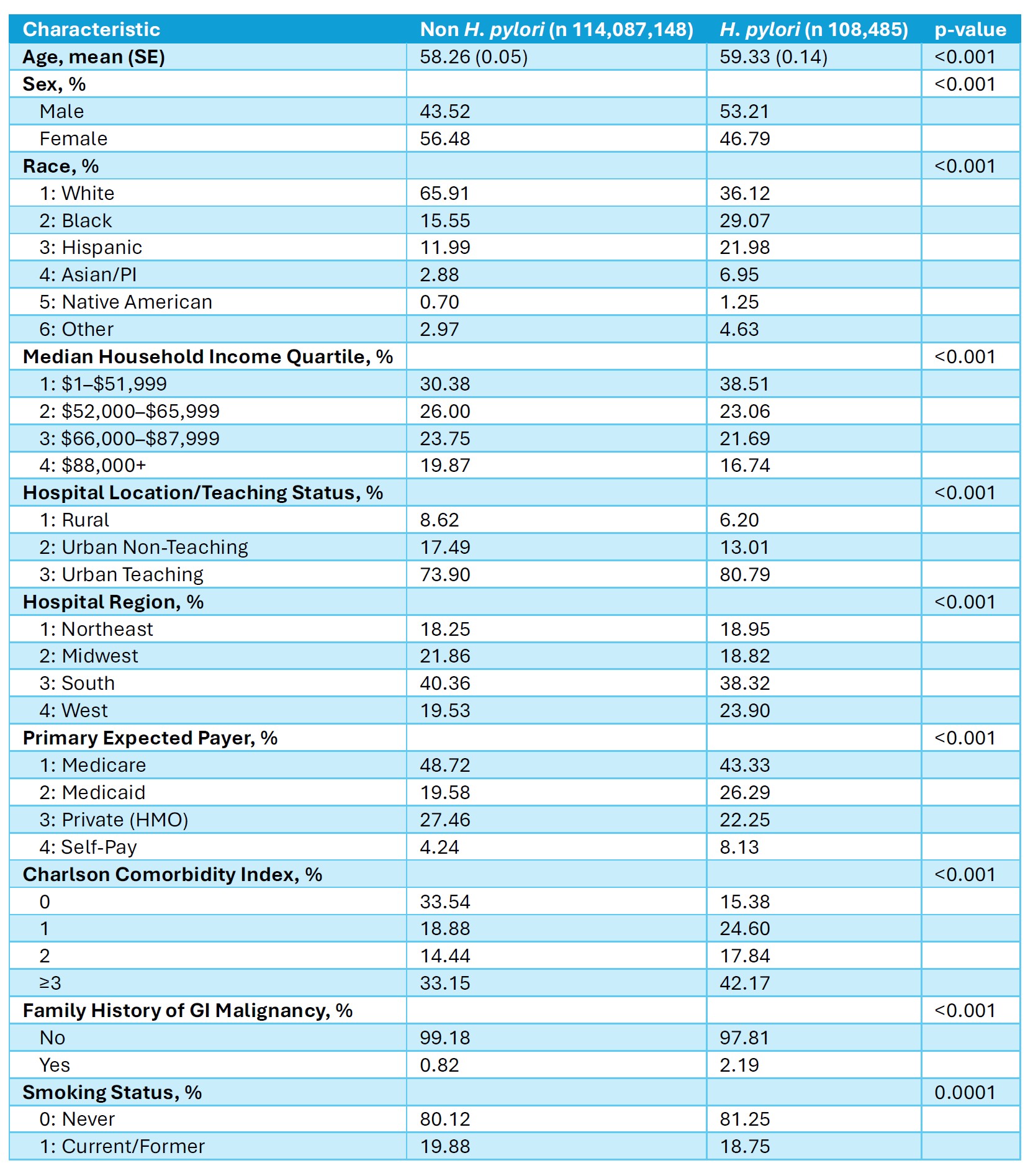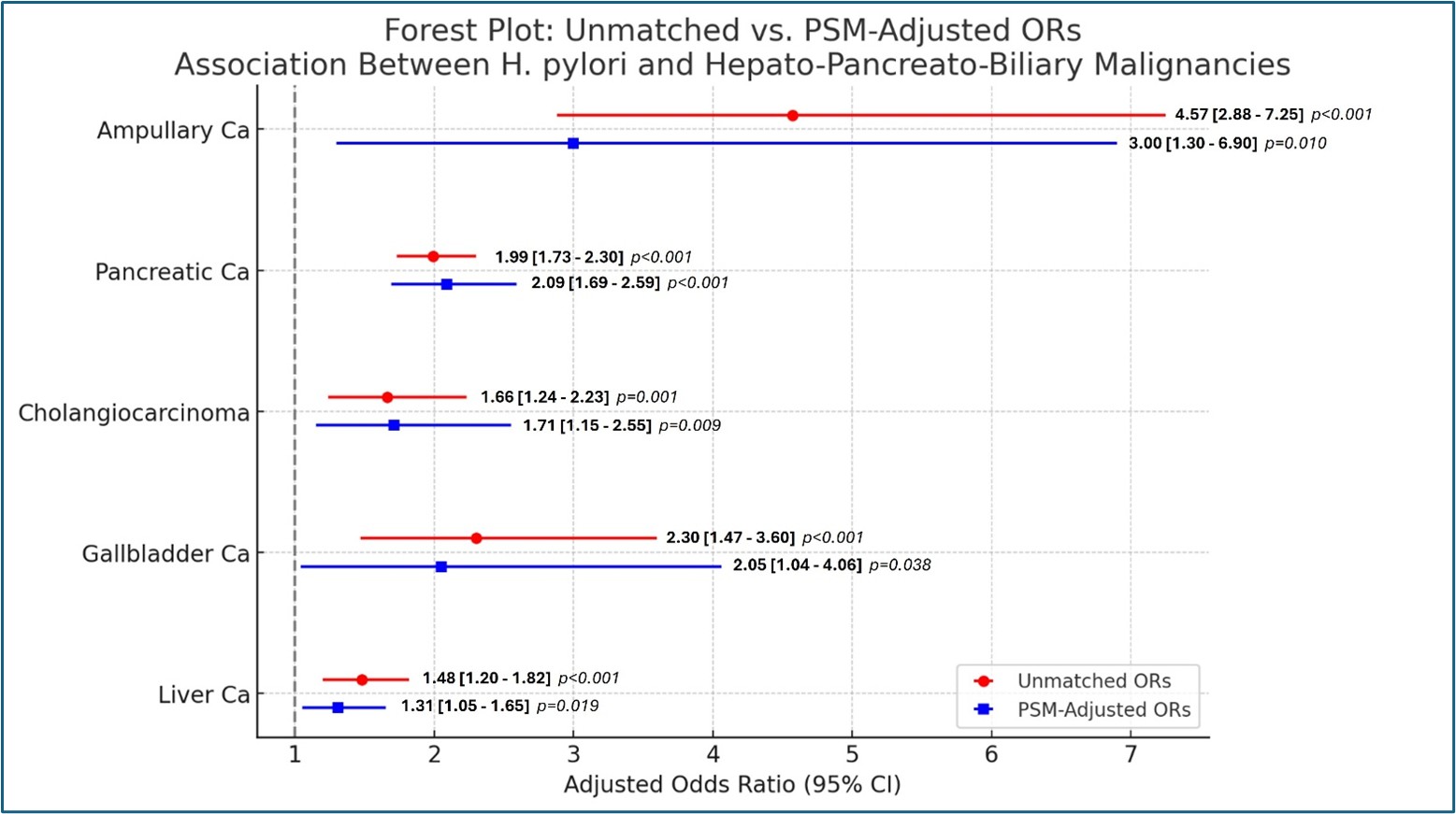Monday Poster Session
Category: Biliary/Pancreas
Association of <i>Helicobacter pylori</i> Infection With Hepatobiliary and Pancreatic Malignancies: A Nationwide Analysis
P2180 - Association of Helicobacter pylori Infection With Hepatobiliary and Pancreatic Malignancies: A Nationwide Analysis
Monday, October 27, 2025
10:30 AM - 4:00 PM PDT
Location: Exhibit Hall

Mohamed Karam Douedari, MD
Mount Sinai Medical Center
Miami Beach, FL
Presenting Author(s)
Mohamed Karam Douedari, MD1, Shria Kumar, MD, MSCE2, Mahmoud Mahfouz, MD2, Rama Tarakji, MD, MPH1
1Mount Sinai Medical Center, Miami Beach, FL; 2University of Miami Miller School of Medicine, Miami, FL
Introduction: H. pylori is known for its role in gastric cancer, but emerging evidence suggests a possible link to hepatobiliary and pancreatic malignancies. Most of these studies originate from high-prevalence regions, and large national studies, especially on rarer malignancies like ampullary cancer, remain limited. This study examines the potential association between H. pylori and Hepatobiliary and Pancreatic malignancies.
Methods: We conducted a retrospective cohort study using the National Inpatient Sample (2019–2022). ICD-10 codes identified adults with H. pylori infection and ampullary, pancreatic, bile duct, gallbladder, and liver cancer, excluding metastatic and unspecified biliary malignancies. Multivariable logistic regression estimated adjusted odds ratios (aORs), controlling for demographics, comorbidities, smoking, family history, socioeconomic status, and hospital factors. We performed propensity score matching with post-matching regression to assess residual confounding. A sub-analysis among H. pylori-positive patients evaluated risk factors for malignancies.
Results: Among 114 million adult discharges, H. pylori infection (n ≈ 108,485) was associated with significantly increased odds for having a co-diagnosis of the studied malignancies. This association remains significant after matching (19,945 with H. pylori, 50,976 matched controls) (Figure 1). Among patients with H. pylori infection, Asian and Pacific Islander race (aOR 1.70, p=0.005), family history of GI malignancy (aOR 1.91, p=0.020), and older age (aOR 1.02/year, p< 0.001) significantly increased the odds of co-diagnosis with studied malignancies; while sex, Black or Hispanic race, and smoking did not.
Discussion: In this analysis of hospitalized patients, H. pylori infection was significantly associated with hepatobiliary and pancreatic malignancies, most strongly with ampullary cancer. This association should be interpreted cautiously due to potential confounding by indication, as many of our H. pylori-positive patients possibly underwent testing for gastrointestinal symptoms. This limitation is common in administrative data studies lacking clinical details. Despite these limitations, our findings, supported by high statistical power, suggest a potential association and highlight the need for longitudinal studies to clarify H. pylori’s role. Future research should use time-to-event methods and examine whether eradication reduces cancer risk, particularly in high-risk groups.

Figure: Table 1: Baseline Characteristics of Inpatient Adults With and Without H. pylori

Figure: Figure 1. Forest Plot of Unmatched and PSM-Adjusted (1:4 nearest-neighbor matching, caliper=0.05) Odds Ratios for the Association Between H. pylori and Hepato-Pancreato-Biliary Malignancies.
Disclosures:
Mohamed Karam Douedari indicated no relevant financial relationships.
Shria Kumar: Phathom Pharmaceuticals – Grant/Research Support, Unrelated to this work. TriMed Americas – Grant/Research Support, Unrelated to this work.
Mahmoud Mahfouz indicated no relevant financial relationships.
Rama Tarakji indicated no relevant financial relationships.
Mohamed Karam Douedari, MD1, Shria Kumar, MD, MSCE2, Mahmoud Mahfouz, MD2, Rama Tarakji, MD, MPH1. P2180 - Association of <i>Helicobacter pylori</i> Infection With Hepatobiliary and Pancreatic Malignancies: A Nationwide Analysis, ACG 2025 Annual Scientific Meeting Abstracts. Phoenix, AZ: American College of Gastroenterology.
1Mount Sinai Medical Center, Miami Beach, FL; 2University of Miami Miller School of Medicine, Miami, FL
Introduction: H. pylori is known for its role in gastric cancer, but emerging evidence suggests a possible link to hepatobiliary and pancreatic malignancies. Most of these studies originate from high-prevalence regions, and large national studies, especially on rarer malignancies like ampullary cancer, remain limited. This study examines the potential association between H. pylori and Hepatobiliary and Pancreatic malignancies.
Methods: We conducted a retrospective cohort study using the National Inpatient Sample (2019–2022). ICD-10 codes identified adults with H. pylori infection and ampullary, pancreatic, bile duct, gallbladder, and liver cancer, excluding metastatic and unspecified biliary malignancies. Multivariable logistic regression estimated adjusted odds ratios (aORs), controlling for demographics, comorbidities, smoking, family history, socioeconomic status, and hospital factors. We performed propensity score matching with post-matching regression to assess residual confounding. A sub-analysis among H. pylori-positive patients evaluated risk factors for malignancies.
Results: Among 114 million adult discharges, H. pylori infection (n ≈ 108,485) was associated with significantly increased odds for having a co-diagnosis of the studied malignancies. This association remains significant after matching (19,945 with H. pylori, 50,976 matched controls) (Figure 1). Among patients with H. pylori infection, Asian and Pacific Islander race (aOR 1.70, p=0.005), family history of GI malignancy (aOR 1.91, p=0.020), and older age (aOR 1.02/year, p< 0.001) significantly increased the odds of co-diagnosis with studied malignancies; while sex, Black or Hispanic race, and smoking did not.
Discussion: In this analysis of hospitalized patients, H. pylori infection was significantly associated with hepatobiliary and pancreatic malignancies, most strongly with ampullary cancer. This association should be interpreted cautiously due to potential confounding by indication, as many of our H. pylori-positive patients possibly underwent testing for gastrointestinal symptoms. This limitation is common in administrative data studies lacking clinical details. Despite these limitations, our findings, supported by high statistical power, suggest a potential association and highlight the need for longitudinal studies to clarify H. pylori’s role. Future research should use time-to-event methods and examine whether eradication reduces cancer risk, particularly in high-risk groups.

Figure: Table 1: Baseline Characteristics of Inpatient Adults With and Without H. pylori

Figure: Figure 1. Forest Plot of Unmatched and PSM-Adjusted (1:4 nearest-neighbor matching, caliper=0.05) Odds Ratios for the Association Between H. pylori and Hepato-Pancreato-Biliary Malignancies.
Disclosures:
Mohamed Karam Douedari indicated no relevant financial relationships.
Shria Kumar: Phathom Pharmaceuticals – Grant/Research Support, Unrelated to this work. TriMed Americas – Grant/Research Support, Unrelated to this work.
Mahmoud Mahfouz indicated no relevant financial relationships.
Rama Tarakji indicated no relevant financial relationships.
Mohamed Karam Douedari, MD1, Shria Kumar, MD, MSCE2, Mahmoud Mahfouz, MD2, Rama Tarakji, MD, MPH1. P2180 - Association of <i>Helicobacter pylori</i> Infection With Hepatobiliary and Pancreatic Malignancies: A Nationwide Analysis, ACG 2025 Annual Scientific Meeting Abstracts. Phoenix, AZ: American College of Gastroenterology.

